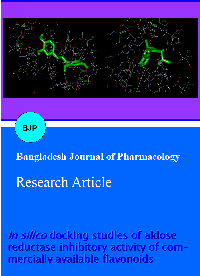In silico docking studies of aldose reductase inhibitory activity of commercially available flavonoids
DOI:
https://doi.org/10.3329/bjp.v7i4.12314Keywords:
Binding energy, Inhibition constant, Intermolecular energy, LigandsAbstract
The primary objective of this study was to investigate the aldose reductase inhibitory activity of flavonoids using in silico docking studies. In this perspective, flavonoids like biochanin, butein, esculatin, fisetin and herbacetin were selected. Epalrestat, a known aldose reductase inhibitor was used as the standard. In silico docking studies were carried out using AutoDock 4.2, based on the Lamarckian genetic algorithm principle. The results showed that all the selected flavonoids showed binding energy ranging between -9.33 kcal/mol to -7.23 kcal/mol when compared with that of the standard (-8.73 kcal/mol). Inhibition constant (144.13 µM to 4.98 µM) and intermolecular energy (-11.42 kcal/mol to -7.83 kcal/mol) of the flavonoids also coincide with the binding energy. All the selected flavonoids contributed aldose reductase inhibitory activity because of its structural properties. These molecular docking analyses could lead to the further development of potent aldose reductase inhibitors for the treatment of diabetes.
Downloads
3367
1068 Read
427
References
Azam F, Prasad MVV, Thangavel N. Molecular docking studies of 1- (substituted phenyl) -3- (naphtha [1,2 d] thiazol -2-yl) urea/thiourea derivatives with human adenosine A2A receptor. Bioinformatics 2011; 6: 330-34.
Cushnie TP, Lamb AJ. Recent advances in understanding the antibacterial properties of flavonoids. Int J Antimicrob Agents. 2011; 38: 99-107.
Dong Y, Yang J, Ren X, Zhang H, He J. New Aldose Reductase Inhibitors N99-596 A and B from Streptomyces. J Antibiot. 2005; 58: 737-39.
Gonzalez R, Ballester I. Effects of flavonoids and other polyphenols on inflammation. Cri Rev Food Sci Nut. 2011; 51: 331-62.
Guzman A, Guerrero OR. Inhibition of aldose reductase by herbs extracts and natural substances and their role in prevention of cataracts. Revista Cubana de Plantas Medicinales. 2005; 10: 3-4.
Hwang CY, Shaw S, Kaneko M, Redd H, Marrero BM, Ramasamy R. Aldose reductase pathway mediates JAK-STAT signaling: A novel axis in myocardial ischemic injury. J Fed Am Soc Exp Biol. 2005; 19: 795-97.
Lamba HS, Bhargava CS, Thakur M, Bhargava S. ? glucosidase and aldose reductase inhibitory activity in vitro and antidiabetic activity in vivo of tribulus terrestris L. (dunal). Int J Pharm Pharmaceut Sci. 2011; 3: 270-72.
Liu H, Wang Z, Qiao Y, Zhou J. Flavonoids with aldose reductase inhibiting activity: Pharmacophore modeling and implications for mechanism. Acta Physico-Chimica Sinica. 2007; 23: 1059-64.
Madeswaran A, Umamaheswari M, Asokkumar K, Sivashanmugam T, Subhadradevi V, Jagannath P. In silico docking studies of lipoxygenase inhibitory activity of commercially available flavonoids. J Comp Methods Mol Des. 2011; 1: 65-72.
Madeswaran A, Umamaheswari M, Asokkumar K, Sivashanmugam T, Subhadradevi V, Jagannath P. Docking studies: In silico phosphodiesterase inhibitory activity of commercially available flavonoids. Bangladesh J Pharmacol. 2012; 7: 70-75.
Nishiumi S, Miyamoto S, Kawabata K, Ohnishi K, Mukai R, Murakami A, Ashida H, Terao H. Dietary flavonoids as cancer-preventive and therapeutic biofactors. Front Biosci. 2011; 3: 1332-62.
Norgan AP, Coffman PK, Kocher JPA, Katzmann DJ, Sosa CP. Multilevel parallelization of AutoDock 4.2. J Cheminform 2011; 3: 12-15.
Ravindranath TM, Mong PY, Ananthakrishnan R, Li Q, Quadri N, Schmidt MA, Ramasamy R, Wang Q. Novel role for aldose reductase in mediating acute inflammatory responses in the lung. J Immunol. 2009; 183: 8128-37.
Saraswat M, Muthenna P, Suryanarayana P, Petrash JM, Reddy G. Dietary sources of aldose reductase inhibitors: prospects for alleviating diabetic complications. Asia Pac J Clin Nut. 2008; 17: 558-65.
Seeliger D, de Grootligand BL. Ligand docking and binding site analysis with PyMOL and Autodock/Vina. J Comp Aided Mol Des. 2010; 24: 417-22.
Umamaheswari M, Madeswaran A, Asokkumar K, Sivashanmugam AT, Subhadradevi V, Jagannath P. Docking studies: Search for possible phytoconstituents for the treatment of gout. Int J Biol Pharm Res. 2012; 3: 6-11.
Umamaheswari M, Madeswaran A, Asokkumar K, Sivashanmugam T, Subhadradevi V, Jagannath P. Study of potential xanthine oxidase inhibitors: In silico and in vitro biological activity biological activity biological activity biological activity. Bangladesh J Pharmacol. 2011; 6: 117-23.
Vianna R, Brault A, Martineau LC, Couture R. In vivo anti-diabetic activity of the ethanolic crude extract of sorbus decora c.k.schneid. (rosacea): a medicinal plant used by canadian james bay cree nations to treat symptoms related to diabetes. Inventi Impact Ethno Pharmacol. 2011; 3: 10-15.
Yadav UCS, Naura AS, Aguirre LA, Ramana KV, Boldogh I, Sur S, Boulares HA, Srivastava SK. Aldose reductase inhibition suppresses the expression of Th2 cytokines and airway inflammation in ovalbumin-induced asthma in mice. J Immunol. 2009; 183: 4723-32.
Zhang S, Kumar K, Jiang X, Wallqvist A, Reifman J. DOVIS: An implementation for high throughput virtual screening using Autodock. BMC Bioinform. 2008; 9: 126-28.

Published
How to Cite
Issue
Section
License
Authors who publish with this journal agree to the following terms:
- Authors retain copyright and grant the journal right of first publication with the work simultaneously licensed under a Creative Commons Attribution License that allows others to share the work with an acknowledgement of the work's authorship and initial publication in this journal.
- Authors are able to enter into separate, additional contractual arrangements for the non-exclusive distribution of the journal's published version of the work (e.g., post it to an institutional repository or publish it in a book), with an acknowledgement of its initial publication in this journal.
- Authors are permitted and encouraged to post their work online (e.g., in institutional repositories or on their website) prior to and during the submission process, as it can lead to productive exchanges, as well as earlier and greater citation of published work (See The Effect of Open Access).
